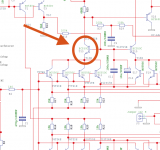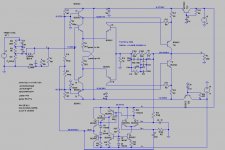Hi carlmart !
... yes cacapity, the thing inside condensers...

I run complete (with all 20 transistors) SLNs / SUPRAs without servo (modified circuit from post #157), in a separate phono preamplifier in its own housing (together with my CX-Decoder ).
Furthermore in a preamplifier, the original Supra with unchanged circuit as in Elektor 7/8-1982. (the input capacity was even given as 280p, I have this Elektor edition)
I have the MM pickups Ortofon OM and Dual TKS236, with both there is no problem with the SUPRA.
In post #292 that was an attempt to see if the circuit works properly with just one pair of inputs. The simulation was OK, but the reality could have been different.
I also wanted to try out the servo and see if I could easily modify the PCBs which are already made.
The servo is IMO only really valid if you absolutely want to set up the circuit without an input and output capacitor. (which is done there)
@peranders
There are also some other topics / contributions to the SLN / SUPRA in the forum, in which the possibly problematic input capacity was mentioned.
Please read there.
For example, a connection capacity of 100-200pF is specified for various Audio Technica VM systems. This can easily be achieved with the player connection cable alone.
.asc file attached!
... yes cacapity, the thing inside condensers...
I run complete (with all 20 transistors) SLNs / SUPRAs without servo (modified circuit from post #157), in a separate phono preamplifier in its own housing (together with my CX-Decoder ).
Furthermore in a preamplifier, the original Supra with unchanged circuit as in Elektor 7/8-1982. (the input capacity was even given as 280p, I have this Elektor edition)
I have the MM pickups Ortofon OM and Dual TKS236, with both there is no problem with the SUPRA.
In post #292 that was an attempt to see if the circuit works properly with just one pair of inputs. The simulation was OK, but the reality could have been different.
I also wanted to try out the servo and see if I could easily modify the PCBs which are already made.
The servo is IMO only really valid if you absolutely want to set up the circuit without an input and output capacitor. (which is done there)
@peranders
There are also some other topics / contributions to the SLN / SUPRA in the forum, in which the possibly problematic input capacity was mentioned.
Please read there.
For example, a connection capacity of 100-200pF is specified for various Audio Technica VM systems. This can easily be achieved with the player connection cable alone.
.asc file attached!
Attachments
Last edited:
I tried different OpAmps lying around here as a DC servo.
From the "vintage parts box": ua741 (metal TO-39) and TBA 221.
Also OPA27 and now OP07. No significant differences in the result.
There are also OP177 and NE5534 that I could put in for a test.
...probably they are all vintage....
I think in this application it makes no audible difference whether the related OPAmp is with FET or BJT.
From the "vintage parts box": ua741 (metal TO-39) and TBA 221.
Also OPA27 and now OP07. No significant differences in the result.
There are also OP177 and NE5534 that I could put in for a test.
...probably they are all vintage....
I think in this application it makes no audible difference whether the related OPAmp is with FET or BJT.
You use FET opamp for servos so the output voltage error is small. Remember the large resistances needed for a long time constant will convert bipolar bias/offset current into definite voltage error in a servo application, or else you'll need a bulky expensive bipolar electrolytic just to keep the resistor smaller.
You are right about that but I chose to have cascodes which eliminates the extra capacitance.Don't forget Miller capacitance!
Best regards!
Attachments
Actually, I don't like using an OpAmp as a DC servo in this case, I think it somehow contradicts this 1982 preamplifier concept, which originally only used BC550/560 transistors that were cheap and easy to get.
If I use OpAmps, I should use them for the MD preamp itself, which makes more sense.
IMO.
So I tried to do the whole thing with BC550/560 only, including DC servo.
The simulation works quite well. Now I have to build it soon to see if it really works.
Any opinions?
If I use OpAmps, I should use them for the MD preamp itself, which makes more sense.
IMO.
So I tried to do the whole thing with BC550/560 only, including DC servo.
The simulation works quite well. Now I have to build it soon to see if it really works.
Any opinions?
Attachments
Weren't T2 and T3 originally current sources rather than voltage followers? With voltage followers, the main amplifier is essentially a pair of differential pairs with folded cascodes. I wonder how much loop gain is left with this set-up.
The bias current of T12 and T13 seems rather unpredictable to me, as it depends on the matching between unequal devices. Why not add an extra diode and emitter resistors, making it a class-A servo amp?
The bias current of T12 and T13 seems rather unpredictable to me, as it depends on the matching between unequal devices. Why not add an extra diode and emitter resistors, making it a class-A servo amp?
By which standard, please? Is there any evidence?...much better are two step, phase stable amplification with passive filter between.
Best regards!
there's no low noise phono with such high impedance riaa network into a bipolar transistor base...So I tried to do the whole thing with BC550/560 only, including DC servo.
The simulation works quite well. Now I have to build it soon to see if it really works.
Any opinions?
Last edited:
With 2SA970/2SC2240 is living easy, especially on drivers with higher voltage and direct usage without reductors.
Also more obsolete. Any you can find is fake.
- Status
- This old topic is closed. If you want to reopen this topic, contact a moderator using the "Report Post" button.
- Home
- Source & Line
- Analogue Source
- BC550 BC560 Very low noise RIAA

 ! It also increases the input stages gain considerably.
! It also increases the input stages gain considerably.